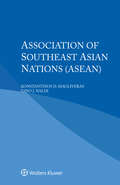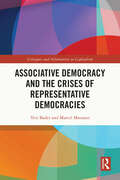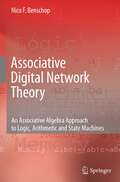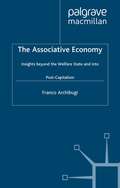- Table View
- List View
Association Models in Epidemiology: Study Designs, Modeling Strategies, and Analytic Methods (Chapman & Hall/CRC Biostatistics Series)
by Hongjie LiuAssociation Models in Epidemiology: Study Designs, Modeling Strategies, and Analytic Methods is written by an epidemiologist for graduate students, researchers, and practitioners who will use regression techniques to analyze data. It focuses on association models rather than prediction models. The book targets students and working professionals who lack bona fide modeling experts but are committed to conducting appropriate regression analyses and generating valid findings from their projects. This book aims to offer detailed strategies to guide them in modeling epidemiologic data.Features Custom-Tailored Models: Discover association models specifically designed for epidemiologic study designs. Epidemiologic Principles in Action: Learn how to apply and translate epidemiologic principles into regression modeling techniques. Model Specification Guidance: Get expert guidance on model specifications to estimate exposure-outcome associations, accurately controlling for confounding bias. Accessible Language: Explore regression intricacies in user-friendly language, accompanied by real-world examples that make learning easier. Step-by-Step Approach: Follow a straightforward step-by-step approach to master strategies and procedures for analysis. Rich in Examples: Benefit from 120 examples, 77 figures, 86 tables, and 174 SAS® outputs with annotations to enhance your understanding. Crafted for two primary audiences, this text benefits graduate epidemiology students seeking to understand how epidemiologic principles inform modeling analyses and public health professionals conducting independent analyses in their work. Therefore, this book serves as a textbook in the classroom and as a reference book in the workplace. A wealth of supporting material is available for download from the book’s CRC Press webpage. Upon completing this text, readers should gain confidence in accurately estimating associations between risk factors and outcomes, controlling confounding bias, and assessing effect modification.
Association Models in Epidemiology: Study Designs, Modeling Strategies, and Analytic Methods (Chapman & Hall/CRC Biostatistics Series)
by Hongjie LiuAssociation Models in Epidemiology: Study Designs, Modeling Strategies, and Analytic Methods is written by an epidemiologist for graduate students, researchers, and practitioners who will use regression techniques to analyze data. It focuses on association models rather than prediction models. The book targets students and working professionals who lack bona fide modeling experts but are committed to conducting appropriate regression analyses and generating valid findings from their projects. This book aims to offer detailed strategies to guide them in modeling epidemiologic data.Features Custom-Tailored Models: Discover association models specifically designed for epidemiologic study designs. Epidemiologic Principles in Action: Learn how to apply and translate epidemiologic principles into regression modeling techniques. Model Specification Guidance: Get expert guidance on model specifications to estimate exposure-outcome associations, accurately controlling for confounding bias. Accessible Language: Explore regression intricacies in user-friendly language, accompanied by real-world examples that make learning easier. Step-by-Step Approach: Follow a straightforward step-by-step approach to master strategies and procedures for analysis. Rich in Examples: Benefit from 120 examples, 77 figures, 86 tables, and 174 SAS® outputs with annotations to enhance your understanding. Book website located here. Crafted for two primary audiences, this text benefits graduate epidemiology students seeking to understand how epidemiologic principles inform modeling analyses and public health professionals conducting independent analyses in their work. Therefore, this book serves as a textbook in the classroom and as a reference book in the workplace. A wealth of supporting material is available for download from the book’s CRC Press webpage. Upon completing this text, readers should gain confidence in accurately estimating associations between risk factors and outcomes, controlling confounding bias, and assessing effect modification.
Association Models in Epidemiology: Study Designs, Modeling Strategies, and Analytic Methods (Chapman & Hall/CRC Biostatistics Series)
by Hongjie LiuAssociation Models in Epidemiology: Study Designs, Modeling Strategies, and Analytic Methods is written by an epidemiologist for graduate students, researchers, and practitioners who will use regression techniques to analyze data. It focuses on association models rather than prediction models. The book targets students and working professionals who lack bona fide modeling experts but are committed to conducting appropriate regression analyses and generating valid findings from their projects. This book aims to offer detailed strategies to guide them in modeling epidemiologic data.Features Custom-Tailored Models: Discover association models specifically designed for epidemiologic study designs. Epidemiologic Principles in Action: Learn how to apply and translate epidemiologic principles into regression modeling techniques. Model Specification Guidance: Get expert guidance on model specifications to estimate exposure-outcome associations, accurately controlling for confounding bias. Accessible Language: Explore regression intricacies in user-friendly language, accompanied by real-world examples that make learning easier. Step-by-Step Approach: Follow a straightforward step-by-step approach to master strategies and procedures for analysis. Rich in Examples: Benefit from 120 examples, 77 figures, 86 tables, and 174 SAS® outputs with annotations to enhance your understanding. Book website located here. Crafted for two primary audiences, this text benefits graduate epidemiology students seeking to understand how epidemiologic principles inform modeling analyses and public health professionals conducting independent analyses in their work. Therefore, this book serves as a textbook in the classroom and as a reference book in the workplace. A wealth of supporting material is available for download from the book’s CRC Press webpage. Upon completing this text, readers should gain confidence in accurately estimating associations between risk factors and outcomes, controlling confounding bias, and assessing effect modification.
Association of Southeast Asian Nations (ASEAN)
by Konstantinos D. Magliveras Gino J. NaldiDerived from the renowned multi-volume International Encyclopaedia of Laws, this practical analysis of the structure, competence, and management of Association of Southeast Asian Nations (ASEAN) provides substantial and readily accessible information for lawyers, academics, and policymakers likely to have dealings with its activities and data. No other book gives such a clear, uncomplicated description of the organization’s role, its rules and how they are applied, its place in the framework of international law, or its relations with other organizations. The monograph proceeds logically from the organization’s genesis and historical development to the structure of its membership, its various organs and their mandates, its role in intergovernmental cooperation, and its interaction with decisions taken at the national level. Its competence, its financial management, and the nature and applicability of its data and publications are fully described. Systematic in presentation, this valuable time-saving resource offers the quickest, easiest way to acquire a sound understanding of the workings of Association of Southeast Asian Nations (ASEAN) for all interested parties. Students and teachers of international law will find it especially valuable as an essential component of the rapidly growing and changing global legal milieu.
Association Rule Hiding for Data Mining (Advances in Database Systems #41)
by Aris Gkoulalas-Divanis Vassilios S. VerykiosPrivacy and security risks arising from the application of different data mining techniques to large institutional data repositories have been solely investigated by a new research domain, the so-called privacy preserving data mining. Association rule hiding is a new technique in data mining, which studies the problem of hiding sensitive association rules from within the data. Association Rule Hiding for Data Mining addresses the problem of "hiding" sensitive association rules, and introduces a number of heuristic solutions. Exact solutions of increased time complexity that have been proposed recently are presented, as well as a number of computationally efficient (parallel) approaches that alleviate time complexity problems, along with a thorough discussion regarding closely related problems (inverse frequent item set mining, data reconstruction approaches, etc.). Unsolved problems, future directions and specific examples are provided throughout this book to help the reader study, assimilate and appreciate the important aspects of this challenging problem. Association Rule Hiding for Data Mining is designed for researchers, professors and advanced-level students in computer science studying privacy preserving data mining, association rule mining, and data mining. This book is also suitable for practitioners working in this industry.
Association Rule Mining: Models and Algorithms (Lecture Notes in Computer Science #2307)
by Chengqi Zhang Shichao ZhangDue to the popularity of knowledge discovery and data mining, in practice as well as among academic and corporate R&D professionals, association rule mining is receiving increasing attention.The authors present the recent progress achieved in mining quantitative association rules, causal rules, exceptional rules, negative association rules, association rules in multi-databases, and association rules in small databases. This book is written for researchers, professionals, and students working in the fields of data mining, data analysis, machine learning, knowledge discovery in databases, and anyone who is interested in association rule mining.
Associational anarchism: Towards a left-libertarian conception of freedom (Contemporary Anarchist Studies)
by Chris WyattAssociational anarchism presents a ground-breaking alternative to both liberal democracy and state socialism, derived from the ideas of Karl Marx and G. D. H. Cole. Uniting the public sphere of citizenship with the private sphere of production in a system of communal ownership, the book proposes a scheme of horizontal networks held together through libertarian politics. With no role for a centralised state, the functions of coordination and administration are fulfilled through pluralist self-governance. Political intermediation proceeds via a web of functional associations, which operate within a system of revitalised communities, while management is carried out through modes of self-regulation that embody the key anarchist values of equality, solidarity and mutual-aid.
Associational anarchism: Towards a left-libertarian conception of freedom (Contemporary Anarchist Studies)
by Chris WyattAssociational anarchism presents a ground-breaking alternative to both liberal democracy and state socialism, derived from the ideas of Karl Marx and G. D. H. Cole. Uniting the public sphere of citizenship with the private sphere of production in a system of communal ownership, the book proposes a scheme of horizontal networks held together through libertarian politics. With no role for a centralised state, the functions of coordination and administration are fulfilled through pluralist self-governance. Political intermediation proceeds via a web of functional associations, which operate within a system of revitalised communities, while management is carried out through modes of self-regulation that embody the key anarchist values of equality, solidarity and mutual-aid.
Associations and Correlations: Unearth The Powerful Insights Buried In Your Data
by Lee BakerUnearth the powerful insights buried in your data
Associations and the Chinese State: Contested Spaces
by Jonathan UngerWhat role do Chinese popular associations play in the expansion of civil society and democratization? Under Mao few associations were permitted to exist, while today over 200,000 associations are officially recognized. Are they important foundations of civil society, or vehicles for state corporatism and control? In this book leading China specialists examine an interesting range of associations, from business associations to trade unions, to urban homeowners associations, women's groups against domestic violence, and rural NGOs that develop anti-poverty programs. The contributors find different important trends underway in different parts of China's economy and society. Their findings are nuanced, insightful - and often not what might be expected.
Associations and the Chinese State: Contested Spaces
by Jonathan UngerWhat role do Chinese popular associations play in the expansion of civil society and democratization? Under Mao few associations were permitted to exist, while today over 200,000 associations are officially recognized. Are they important foundations of civil society, or vehicles for state corporatism and control? In this book leading China specialists examine an interesting range of associations, from business associations to trade unions, to urban homeowners associations, women's groups against domestic violence, and rural NGOs that develop anti-poverty programs. The contributors find different important trends underway in different parts of China's economy and society. Their findings are nuanced, insightful - and often not what might be expected.
The Associations Of Classical Athens: The Response To Democracy
by Nicholas F. JonesJones' book examines the associations of ancient Athens under the classical democracy (508/7-321 B.C.) in light of their relations to the central government. Associations of all types--village communities, cultic groups, brotherhoods, sacerdotal families, philosophical schools, and others--emerge as fundamentally similar instances of Aristoteliankoinoniai. Each, it is argued, acquired its distinctive character in response to particular features of the contemporary democracy. The analysis results in the first integrated, holistic institutional reconstruction of Greece's first city.
The Associations of Classical Athens: The Response to Democracy
by Nicholas F. JonesJones' book examines the associations of ancient Athens under the classical democracy (508/7-321 B.C.) in light of their relations to the central government. Associations of all types--village communities, cultic groups, brotherhoods, sacerdotal families, philosophical schools, and others--emerge as fundamentally similar instances of Aristotelian koinoniai. Each, it is argued, acquired its distinctive character in response to particular features of the contemporary democracy. The analysis results in the first integrated, holistic institutional reconstruction of Greece's first city.
Associative Algebras (Graduate Texts in Mathematics #88)
by R.S. PierceFor many people there is life after 40; for some mathematicians there is algebra after Galois theory. The objective ofthis book is to prove the latter thesis. It is written primarily for students who have assimilated substantial portions of a standard first year graduate algebra textbook, and who have enjoyed the experience. The material that is presented here should not be fatal if it is swallowed by persons who are not members of that group. The objects of our attention in this book are associative algebras, mostly the ones that are finite dimensional over a field. This subject is ideal for a textbook that will lead graduate students into a specialized field of research. The major theorems on associative algebras inc1ude some of the most splendid results of the great heros of algebra: Wedderbum, Artin, Noether, Hasse, Brauer, Albert, Jacobson, and many others. The process of refine ment and c1arification has brought the proof of the gems in this subject to a level that can be appreciated by students with only modest background. The subject is almost unique in the wide range of contacts that it makes with other parts of mathematics. The study of associative algebras con tributes to and draws from such topics as group theory, commutative ring theory, field theory, algebraic number theory, algebraic geometry, homo logical algebra, and category theory. It even has some ties with parts of applied mathematics.
Associative and Endophytic Nitrogen-fixing Bacteria and Cyanobacterial Associations (Nitrogen Fixation: Origins, Applications, and Research Progress #5)
by Claudine Elmerich William E. NewtonThis self-contained volume covers fundamental and applied aspects of nitrogen-fixation research. The book describes milestones in the discovery of the associative and endophytic nitrogen-fixing bacteria found involved with cereal crops, forage grasses, and sugar cane. It provides a comprehensive overview of their phylogeny, physiology, and genetics as well as of the biology of their association with their host plants, including tools for in situ localization and population-dynamics analysis. Also included are chapters describing the functions required for a bacterium to be competent and competitive in the rhizosphere, and analysis of associations of cyanobacteria with fungi, diatoms, bryophytes, cycads, Azolla, and Gunnera.
Associative and Non-Associative Algebras and Applications: 3rd MAMAA, Chefchaouen, Morocco, April 12-14, 2018 (Springer Proceedings in Mathematics & Statistics #311)
by Mercedes Siles Molina Laiachi El Kaoutit Mohamed Louzari L’Moufadal Ben Yakoub Mohamed BenslimaneThis book gathers together selected contributions presented at the 3rd Moroccan Andalusian Meeting on Algebras and their Applications, held in Chefchaouen, Morocco, April 12-14, 2018, and which reflects the mathematical collaboration between south European and north African countries, mainly France, Spain, Morocco, Tunisia and Senegal. The book is divided in three parts and features contributions from the following fields: algebraic and analytic methods in associative and non-associative structures; homological and categorical methods in algebra; and history of mathematics. Covering topics such as rings and algebras, representation theory, number theory, operator algebras, category theory, group theory and information theory, it opens up new avenues of study for graduate students and young researchers. The findings presented also appeal to anyone interested in the fields of algebra and mathematical analysis.
Associative Computing: A Programming Paradigm for Massively Parallel Computers (Frontiers in Computer Science)
by Jerry L. PotterIntegrating associative processing concepts with massively parallel SIMD technology, this volume explores a model for accessing data by content rather than abstract address mapping.
Associative Democracy: The Real Third Way
by Veit Bader Paul HirstThis book aims to unlock the current crisis in democratic accountability by supplementing representative democracy with democratic governance in civil society.
Associative Democracy: New Forms of Economic and Social Governance
by Paul HirstIn this book Paul Hirst makes a major contribution to democratic thinking, advocating "associative democracy"; the belief that human welfare and liberty are best served when as many of the affairs of society as possible are managed by voluntary and democratically self-governing associations.
Associative Democracy: New Forms of Economic and Social Governance
by Paul HirstIn this book Paul Hirst makes a major contribution to democratic thinking, advocating "associative democracy"; the belief that human welfare and liberty are best served when as many of the affairs of society as possible are managed by voluntary and democratically self-governing associations.
Associative Democracy: The Real Third Way
by Paul Hirst Veit BaderThis book aims to unlock the current crisis in democratic accountability by supplementing representative democracy with democratic governance in civil society.
Associative Democracy and the Crises of Representative Democracies (Critiques and Alternatives to Capitalism)
by Veit Bader Marcel MaussenThe familiar problems of democratic capitalism have given way to a deep crisis challenging the basic forms of governance introduced around the late 18th century and then gradually expanded and developed until the late 20th century. Associative Democracy and the Crises of Representative Democracies argues that we are in urgent need of normative guidelines and a strong understanding of a broad range of institutional options and innovative experiments in associative democracy in order to address the structural problems that existing institutional arrangements are confronted with whilst maintaining and strengthening democratic forms of government and governance. The argument is developed against the background of a thorough survey of empirical social scientific studies on the crises of capitalisms and representative democracies. This book focuses primarily on democratic alternatives, though it also works out principles and institutions of democratic socialism as alternatives to capitalism. After introducing the theoretical approach, the book illustrates the ways this framework of analysis can be of use, with particular focus on three issues that are highly topical when it comes to the challenges our institutions are confronted with: democratic governance in relation to ecological crises and uncertainty; the threats to democracy raised by the crisis of political parties and representative party-democracy, and the challenges related to privatization and marketization of public services, particularly in healthcare. The book concludes by exploring opportunities to democratize the economy, locating viable alternatives to capitalism in the tradition of democratic socialism. This urgent and thought-provoking book will be of great interest to academics and students in various disciplines in the humanities and social sciences, including political science, sociology, and economics.
Associative Democracy and the Crises of Representative Democracies (Critiques and Alternatives to Capitalism)
by Veit Bader Marcel MaussenThe familiar problems of democratic capitalism have given way to a deep crisis challenging the basic forms of governance introduced around the late 18th century and then gradually expanded and developed until the late 20th century. Associative Democracy and the Crises of Representative Democracies argues that we are in urgent need of normative guidelines and a strong understanding of a broad range of institutional options and innovative experiments in associative democracy in order to address the structural problems that existing institutional arrangements are confronted with whilst maintaining and strengthening democratic forms of government and governance. The argument is developed against the background of a thorough survey of empirical social scientific studies on the crises of capitalisms and representative democracies. This book focuses primarily on democratic alternatives, though it also works out principles and institutions of democratic socialism as alternatives to capitalism. After introducing the theoretical approach, the book illustrates the ways this framework of analysis can be of use, with particular focus on three issues that are highly topical when it comes to the challenges our institutions are confronted with: democratic governance in relation to ecological crises and uncertainty; the threats to democracy raised by the crisis of political parties and representative party-democracy, and the challenges related to privatization and marketization of public services, particularly in healthcare. The book concludes by exploring opportunities to democratize the economy, locating viable alternatives to capitalism in the tradition of democratic socialism. This urgent and thought-provoking book will be of great interest to academics and students in various disciplines in the humanities and social sciences, including political science, sociology, and economics.
Associative Digital Network Theory: An Associative Algebra Approach to Logic, Arithmetic and State Machines
by Nico F. BenschopAssociative Digital Network Theory is intended for researchers at industrial laboratories,teachers and students at technical universities, in electrical engineering, computer science and applied mathematics departments, interested in new developments of modeling and designing digital networks (DN: state machines, sequential and combinational logic) in general, as a combined math/engineering discipline. As background an undergraduate level of modern applied algebra (Birkhoff-Bartee: Modern Applied Algebra - 1970, and Hartmanis-Stearns: Algebraic Structure of Sequential Machines - 1970) will suffice. Essential concepts and their engineering interpretation are introduced in a practical fashion with examples. The motivation in essence is: the importance of the unifying associative algebra of function composition (viz. semigoup theory) for the practical characterisation of the three main functions in computers, namely sequential logic (state-machines), arithmetic and combinational (Boolean) logic.
The Associative Economy: Insights beyond the Welfare State and into Post-Capitalism
by Franco ArchibugiAre Welfare States in crisis? Forty years after Gunnar Myrdal's seminal Beyond the Welfare State it is still little grasped in the 'reform' debate that the whole structure and economies of our societies are being transformed. This book reasserts the importance of a new employment and productive model - that of the 'associative economy' - which integrates social solidarity with economic planning.

















